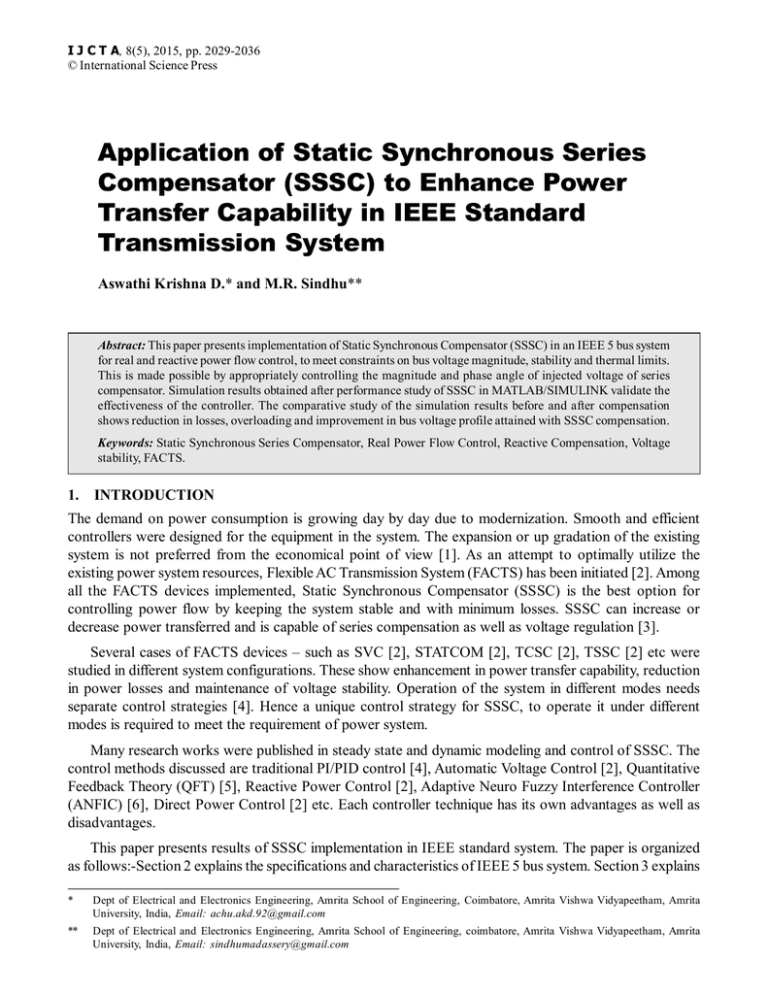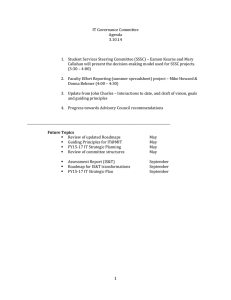Application of Static Synchronous Series Compensator (SSSC) to
advertisement

I J C T A, 8(5), 2015, pp. 2029-2036 © International Science Press Application of Static Synchronous Series Compensator (SSSC) to Enhance Power Transfer Capability in IEEE Standard Transmission System Aswathi Krishna D.* and M.R. Sindhu** Abstract: This paper presents implementation of Static Synchronous Compensator (SSSC) in an IEEE 5 bus system for real and reactive power flow control, to meet constraints on bus voltage magnitude, stability and thermal limits. This is made possible by appropriately controlling the magnitude and phase angle of injected voltage of series compensator. Simulation results obtained after performance study of SSSC in MATLAB/SIMULINK validate the effectiveness of the controller. The comparative study of the simulation results before and after compensation shows reduction in losses, overloading and improvement in bus voltage profile attained with SSSC compensation. Keywords: Static Synchronous Series Compensator, Real Power Flow Control, Reactive Compensation, Voltage stability, FACTS. 1. INTRODUCTION The demand on power consumption is growing day by day due to modernization. Smooth and efficient controllers were designed for the equipment in the system. The expansion or up gradation of the existing system is not preferred from the economical point of view [1]. As an attempt to optimally utilize the existing power system resources, Flexible AC Transmission System (FACTS) has been initiated [2]. Among all the FACTS devices implemented, Static Synchronous Compensator (SSSC) is the best option for controlling power flow by keeping the system stable and with minimum losses. SSSC can increase or decrease power transferred and is capable of series compensation as well as voltage regulation [3]. Several cases of FACTS devices – such as SVC [2], STATCOM [2], TCSC [2], TSSC [2] etc were studied in different system configurations. These show enhancement in power transfer capability, reduction in power losses and maintenance of voltage stability. Operation of the system in different modes needs separate control strategies [4]. Hence a unique control strategy for SSSC, to operate it under different modes is required to meet the requirement of power system. Many research works were published in steady state and dynamic modeling and control of SSSC. The control methods discussed are traditional PI/PID control [4], Automatic Voltage Control [2], Quantitative Feedback Theory (QFT) [5], Reactive Power Control [2], Adaptive Neuro Fuzzy Interference Controller (ANFIC) [6], Direct Power Control [2] etc. Each controller technique has its own advantages as well as disadvantages. This paper presents results of SSSC implementation in IEEE standard system. The paper is organized as follows:-Section 2 explains the specifications and characteristics of IEEE 5 bus system. Section 3 explains * Dept of Electrical and Electronics Engineering, Amrita School of Engineering, Coimbatore, Amrita Vishwa Vidyapeetham, Amrita University, India, Email: achu.akd.92@gmail.com ** Dept of Electrical and Electronics Engineering, Amrita School of Engineering, coimbatore, Amrita Vishwa Vidyapeetham, Amrita University, India, Email: sindhumadassery@gmail.com 2030 Aswathi Krishna D. and M.R. Sindhu in detail the control strategy of SSSC. Section 4 presents simulation results after the installation of SSSC in the IEEE standard 5 bus system. 2. TEST SYSTEM IEEE standard 5 bus system shown in Figure.1 is the selected test system. It consists of 2 generating plants, 3 load buses, 1 PV bus and 7 transmission lines [7]. Bus 1 is set as swing bus. Base kV and base MVA for the system is selected as 100kV and 100 MVA respectively. Therefore base impedance and base current are 100Ù and 1000A respectively. Bus data, Transmission line parameters and load flow analysis results in IEEE standard 5 bus system are shown in table 1 and 2. Figure 1: IEEE 5 Bus System Table 1 Bus data Node 1 2 3 4 5 P (p.u) (generated) Q (p.u) (generated) P (p.u) (demand) Q(p.u) (demand) 1.526 0.3 0 0 0 0.6584 -0.6512 0 0 0 0 0 0.45 0.80 0.50 0 0 0.20 0.30 0.25 Table 2 Transmission Line Parameters Transmission Line 1-2 1-3 2-3 2-4 2-5 3-4 4-5 Impedance (p.u) Line Charging (y/2)(p.u) 0.02+j0.06 0.08+.j0.24 0.06+j0.18 0.06+j0.18 0.04+j0.12 0.01+j0.03 0.08+j0.24 j0.03 j0.025 j0.020 j0.020 j0.015 j0.010 j0.025 Application of Static Synchronous Series Compensator (SSSC) to Enhance Power Transfer... 2031 Waveforms of each of the Bus voltages are shown in the figure 2. From the above results, it is seen that the system attains steady state. Power generation and power demand are balanced. Voltage angle difference between two neighboring buses exceeding 6� results in overloading [8]. Hence from the results, line 2-4 is overloaded. SSSC is implemented to enhance power transfer capability in line 2-4 3. CONTROL STRATEGY OF SSSC Load flow equations that regulate power system are: Table 3 Power Flow in Transmission Lines Node 1 Node 2 S12(p.u) S21(p.u) 1 2 1.0087+0.5250i –0.9846–0.5158i 1 3 0.5173+0.1333i –0.4960–0.1210i 2 3 0.3376+0.0087i –0.3307+0.0099i 2 4 0.4022+0.0149i –0.3925+0.0049i 2 5 0.5448–0.1118i –05326+0.1188i 3 4 0.3768–0.0691i –0.3752+0.0545i 4 5 –0.0323–0.0727i 0.0326+0.0250i Figure 2: Bus Voltages in IEEE 5 Bus System 2032 Aswathi Krishna D. and M.R. Sindhu n PGi � PDi � � | Vi || V j || Yij | cos(�ij � � i � � j ) � 0 j �i (1) n QGi � QDi � � | Vi || V j || Yij | sin(�ij � � i � � j ) � 0 j �1 (2) Where PGi = Real power generation at i th bus. PDi = Real power demand at i th bus. QGi = Reactive power generation at bus. QDi = reactive power demand at bus. The load flow in the system should satisfy a set of constraints-constraints on real and reactive generator power outputs, bus voltage magnitude constraints, constraints on tap setting transformers, capacitor bank reactive power specifications, loading limit on transmission lines and voltage stability limits. The constraints are mathematically represented as, (1) Generator real and reactive power output constraints PGi min � PGi � PGi max ; i � 1, 2,....N G QGi min � QGi � QGi max ; i � 1, 2,....N G (3) (2) Voltage magnitude of each bus min max | Vi |0.9 pu �| Vi |�| Vi |1.1 pu ; i � 1, 2,... N (4) Ti min � Ti � Ti max ; i � 1, 2....N (5) (3) Tap setting of transformers (4) Capacitive bank reactive power output limits QCi min � QC � QCi max ; i � 1, 2.....NC (6) (5) Loading on transmission line Si � Si max ; i � 1, 2...N L (7) SSSC can improve the power transfer capability of transmission line 2-4. The control strategy should also satisfy the limits on SSSC series injected voltage. | Vse |min �| Vse |�| Vse |max Qse min � Qse � Qse max (8) The overall control strategy of SSSC includes: (1) A central controller generates bus voltage and real power flow reference values. (2) SSSC controller to attain required settings of real power, reactive power and bus voltages keeping thermal and voltage transmission constraints. Application of Static Synchronous Series Compensator (SSSC) to Enhance Power Transfer... 2033 According to table 3, flow of real power and reactive power in transmission line without any compensation is 0.4022p.u, 0.0149p.u respectively. 5. REAL POWER CONTROL MODE Since line 2-4 is overloaded, SSSC is installed to reduce the reactive power flow and real power through the line. When SSSC is connected to the line, reactive and real power flow are reached to the limits 0.43pu (430MW) and 0.154pu (154MW) respectively. The change in bus voltage magnitudes and phase angle can be noted from plots shown below. Above simulation results show that: 1. SSSC improves bus voltages in order to meet the desired power flow. 2. SSSC increases the real power flow through the transmission line 2 – 4 from 0.4022 p.u to 0.43 p.u. 3. The effect of SSSC in variation of real power transmitted through each line can be obtained by comparing table 3 and figure5. The SSSC is operated in real power flow mode by applying proper control signals for series controller. Series controller injects voltage in series with the transmission line whose real power and reactive power Figure 3: Reference Voltage Magnitudes in Each Phase 2034 Aswathi Krishna D. and M.R. Sindhu Figure 4: Bus Voltages after Series Voltage Injection has to be controlled. Equations for determining the series voltage to be injected for obtaining required P and Q through the line are P4 � jQ4 � (V4 �� 4 ) I * P4 � jQ4 � (V4 �� 4 )[[(V4�� 4 ) � (V2 �� 2 )]Y ]* ' ' * � P4 � jQ4 � ' ' � � � ��(V4 �� 4 ) � (V2 �� 2 ) �� Y � V4 �� 4 � � 1 � P � jQ �* � 4 (V2 �� 2 ) � (V4 �� 4 ) � � � 4 � � �� Y � V4 �� 4 � �� ' ' (9) 6. RESULTS AND DISCUSSIONS Static Synchronous Compensator is a FACTS device which can control the reactive and real power flow through transmission lines. Desired amount of power flow is achieved by injecting a voltage of controlled phase angle and magnitude in series with transmission line. The voltage injected in simulated system was capable of increasing the real power flow through transmission line 2–4 from 0.407 p.u to the desired value of 0.43 p.u. Power flow through each transmission line has varied accordingly so as to avoid overloading between two neighboring buses. Power flow through the transmission lines in IEEE 5 bus system after series voltage injection is shown in figure 13. Application of Static Synchronous Series Compensator (SSSC) to Enhance Power Transfer... 2035 Figure 5: Power Flow through the Transmission Lines in UPFC Connected System 7. CONCLUSION This paper presented the performance characteristics of SSSC installed in IEEE standard 5 bus system. Without SSSC, transmission line 2-4 shows overloading. By installing SSSC in the line, series inverter injects real power and reactive power of 0.43 p.uand 0.14 p.u respectively. The compensation system shows reduction in loading of the line. In both the cases, all the bus voltages are in nominal voltage limits. Real power and reactive power losses in the system are reduced with SSSC compensation. Acknowledgment The authors would like to thank Amrita Vishwa Vidyapeetham and Department of science and technology for the support for carrying out this project work. References [1] Mashayekh S., Butler-purry K.L., “Transient operational constraints in power system optimization problems”, IEEE Power and Energy Society General Meeting, July 2012. [2] Narain G. Hingorani, Laszlo Gyugi, “Understanding FACTS: Concept and Technology of Flexible AC Transmission Systems”, IEEE Power Engineering Society, 1999. [3] Kalyan K. Sen, “SSSC-Static Synchronous Series Compensator: Theory, Modeling, and Applications”, IEEE Transactions on Power Delivery, Vol. 13, No. 1, January 1998. [4] Fernando Silva, J. Monteiro, S.F. Pinto, J. Palma, “Matrix Converter-Based Unified Power Flow Controllers:Advanced Direct Power Control Method”, IEEE Transaction on Power Delivery, Vol. 26, No. 1, January 2011. [5] Mehdi Nikzad, Shoorangiz Shams Shamsabad Farahani, Ali Javadian “Comparison of Robust Control Method Performance in the UPFC Controllers Design”, Indian Journal of Science and Technology, Vol. 4, No. 6, June 2011. [6] S. Suresh Kumar, B. Gopinath, Juvan Michael, “Unified Power Flow Controller for Dynamic Stability in Power System Using Modern Control Techniques”, International Journal of Engineering and Advanced Technology, Vol. 2, April 2013. [7] R. Jayabarathi, M.R.Sindhu, T.N.P. Nambiar, “Development of a Laboratory Model of hybrid Static Var Compensator”, IEEE Power India Conference, 2006, New Delhi. [8] Enrique Acha, Manual Madrigal, “Power Systems Harmonics: Computer Modelling and Analysis”, John Wiley and Sons, 2001. 2036 Aswathi Krishna D. and M.R. Sindhu [9] R. Thirumalaivasan, M. Janaki, Nagesh Prabhu, “Damping of SSR Using Subsynchronous Current Suppressor With SSSC”, IEEE Transactions on Power Systems, Vol. 28, No. 1, February 2013. [10] Mohamed Shawky El Moursi, Jim. L. Kirtley, Mohamed Abdel-Rahman, “Application of Series Voltage Boosting Schemes for Enhanced Fault Ridethrough Performance of Fixed Speed Wind Turbines”, IEEE transactions on Power Delivery, Vol. 29, No. 1, February 2014. [11] Kamal Al-Haddad, Ambrish Chandra, Bhim Singh, “A Review of Active Filters for Power Quality Improvement”, IEEE Transactions on Industrial Electronics, Vol. 46, No. 5, October 1999. [12] Gyugyi, T.R Rietman, Edris, D. Schauder, R Torgerson, S.L. Williams, “The Unified Power Flow Controller: A New Approach to Power Transmission Control”, IEEE Transactions on Power Delivery, Vol. 10, No. 2, Pages: 1085-1097, April 1995. [13] Yongmei Gan, Renyuan Zhang, “Distributed supervisory control solution for under-load tap-changing transformers”, IEEE Region 10 Conference, Oct. 2013. [14] T.J.E Miller, E. Acha, V.G. Aggelidis, O. Anaya-Lara, “Power Electronics Control in Electrical Systems”, Newnes Power Engineering Series, 1999.



